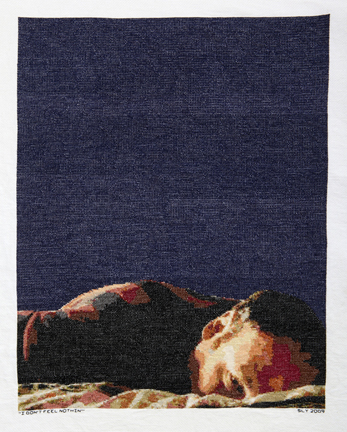About the Photographer
Yeapanis, Stacia
American, b. 1977
Stacia Yeapanis makes art that uses the language of a generation captivated by pop culture, cunningly exploiting the mechanisms of television and computer games to create mixed-media works involving photography, video, performance, computer simulation, and the Internet. For Yeapanis, pop culture is a navigational tool, a useful platform for finding her way through a world of ubiquitous media; it yields metaphors for her life that enable her to search for meaning in the mundane.
The series "Everybody Hurts" (2004-present) is a collection of embroidered television screen captures of TV characters in emotionally charged moments. When a character suffers on television, Yeapanis sympathizes, and she simultaneously explores and analyzes her emotional responses to the illusory misery of the character. In an effort to relish this pained moment, Yeapanis digitally captures TV characters experiencing sadness, guilt, fear, or instances in which their worldviews are shattered. She then elaborately embroiders a reproduction, freezing the fleeting instant of television anguish. The cross-stitch grid mimics the raster pattern on a television screen. The solid color background, reminiscent of Renaissance Dutch portraits, and the dramatic light on the characters’ faces clearly depict the fictional TV characters they represent. Below each image Yeapanis sews a quotation from the respective character that speaks to his or her emotion but is also generic enough for viewers to insert themselves. For instance, in Buffy Summers #1 the caption reads, “They say, if you think you're crazy, you're probably not, but I just don't know what's real anymore."
Yeapanis goes beyond the ordinary viewer’s enthusiasm of these television shows and into the realm of fandom. Although viewers fashion their own meanings out of the messages created by media, Yeapanis goes out of her way to communicate her found messages, by making art (both as a conceptual artist and as genuine fan) for a diverse audience—members of the art world and her fellow fan-club enthusiasts. Everybody Hurts was also a hybrid art/fan website, where other fans could view her large collection of screen captures yet to be embroidered and engage in dialogue with each other regarding the trials and tribulations of these fictional personalities. By publicly exposing her personal anxieties through her diverse practice—web presence and art exhibitions—Yeapanis as fan-turned-artist speaks clearly to a generation searching for significant meaning in a media-saturated world.
At the same time, Yeapanis pushes the boundaries that divide art from craft and public from private. Her cross-stitched renditions of television moments join Maria Piñeres’s embroidered mug shots of celebrities and Ghada Amer’s elaborate embroidered images of women copied from pornography to critique the tradition that has classified cross-stitching simply as craft and women’s work, bringing it into mainstream contemporary art. There is an interesting but complicated parallel here with the historical struggle of photography itself to escape from craft into art.
- Adapted from Natasha Egan, "The Thin Line Between Virtual and Reality" in MP3 (Midwest Photographers Publication Project), Volume II.



